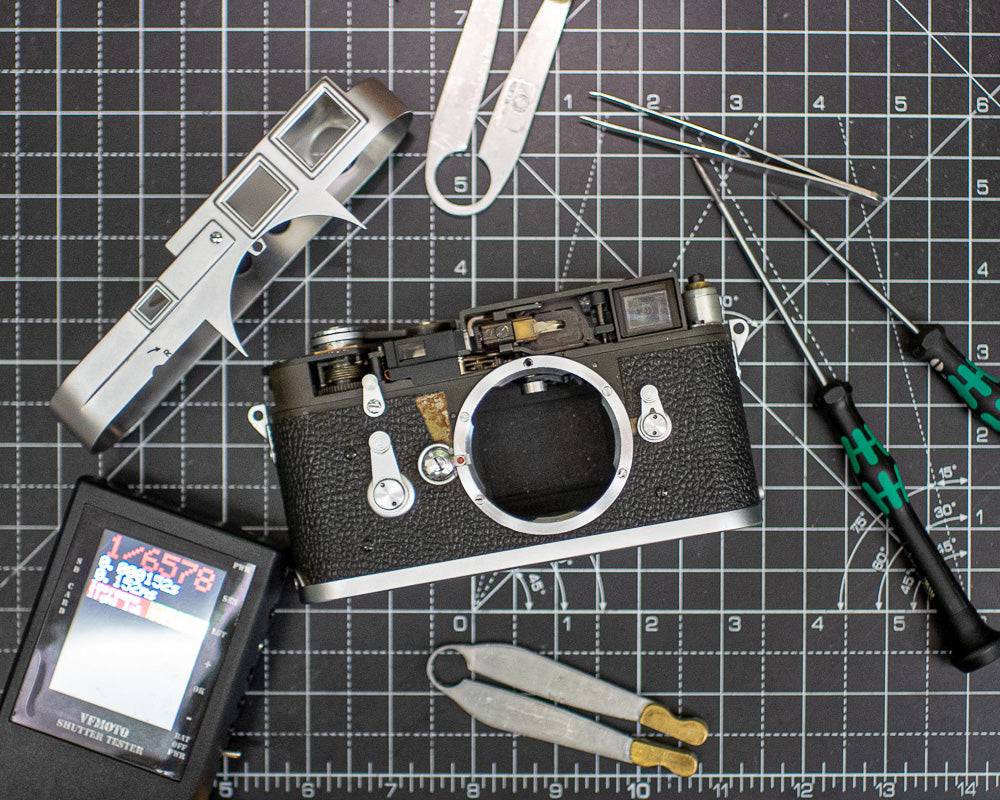Not sure if your shutter is working properly? If the slow speeds are sticking, or the fast speeds are capping then a service is needed. But how do you know if a repair was successful, and the shutter speeds are accurate? You might end up using a shutter speed tester, an audio app, or even just saying "One-Mississippi" and hoping for the best.
However carefully or diligently you might fettle and fine-tune a shutter mechanism, you'll never get the speeds to be exactly right down to the millisecond. That's where an acceptable tolerance comes in. Shutter speed timings that fall in this range can be deemed to be within specification.
The following specification is the DIN 19015 Focal Plane Shutter Standards.
(That's the "Deutsches Institut für Normung" - or German Institute for Standardisation to us).
| Nominal Speed | Lower Tolerance | Upper Tolerance |
| 1/1 (1000ms) | 812ms | 1231ms |
| 1/2 (500ms) | 406ms | 616ms |
| 1/4 (250ms) | 203ms | 308ms |
| 1/8 (125ms) | 102ms | 154ms |
| 1/15 (66.7ms) | 50.8ms | 76.9ms |
| 1/30 (33.3ms) | 25.4ms | 38.5ms |
| 1/60 (16.7ms) | 12.7ms | 19.2ms |
| 1/125 (8ms) | 6.35ms | 9.62ms |
| 1/250 (4ms) | 2.86ms | 5.34ms |
| 1/500 (2ms) | 1.43ms | 2.67ms |
| 1/1000 (1ms) | 0.77ms | 1.33ms |
| 1/2000 (0.5ms) | 0.38ms | 0.65ms |
| 1/4000 (0.25ms) | 0.19ms | 0.33ms |
It's worth noting that leaf shutters, and other standards organisations have slightly different tolerance figures - but the DIN standard above should get you close enough.
Just a bunch of numbers, right? Here's an example:
The shutter speed on a camera is set to 1/125th of a second. If you divide 1 by 125, the perfect exposure time for this would be 8ms. The measured exposure time is - let's say 7.2ms - it would fall into an acceptable range of between 6.35 and 9.62ms on the chart above.
Another example - the shutter on a camera was set to 1/15th of a second. The perfect exposure time for this would be 66.7ms. The measured exposure time is 170ms - this falls far outside the acceptable range of 60.8-76.9ms and indicates a shutter issue.
Why do my shutter speeds need to be so accurate?
If a mechanical shutter is running too fast - or more commonly - too slow, then exposure will be incorrect and the resulting photos will come out brighter or darker than expected.
What is shutter capping?
Shutter capping occurs when the two curtains of a focal plane shutter are moving too quickly or too slowly in relation to each other. It results in a dark, underexposed (or sometimes completely unexposed) area of the frame. This could be at the top or bottom of the frame in a vertically running shutter, or at the side of a frame in a horizontally running shutter.
What causes shutters to be inaccurate?
Most of the time, mechanical shutters become inaccurate or inoperative due to dried up lubricant through age or lack of use. These can usually be serviced and brought back to working order and within specification.
Sometimes, if it's an electronically controlled shutter, it can be caused by power issues or ageing electronic components.
We check the shutter of every camera that comes through us. To learn more, take a look at How We Do It and for an explanation of our condition ratings system, check out How We Grade.
Well, actually...
If you've spotted something not quite right in this article and are feeling particularly pedantic, feel free to Contact Us and let us know. Much like our shutters - we would like our advice to be accurate!
By Howard Parker

